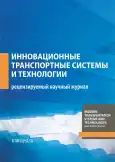Акустическое обнаружение транспортных средств аварийных служб с использованием сверхточных нейронных сетей
- Авторы: Лисов А.А.1, Кулганатов А.З.1, Панишев С.А.1
-
Учреждения:
- Южно-Уральский государственный университет
- Выпуск: Том 9, № 1 (2023)
- Страницы: 95-107
- Раздел: Оригинальные статьи
- URL: https://journals.rcsi.science/transj/article/view/126662
- DOI: https://doi.org/10.17816/transsyst20239195-107
- ID: 126662
Цитировать
Полный текст
Аннотация
Обоснование: Сирена – это особый сигнал, подаваемый транспортными средствами службы экстренной помощи, такими как: пожарные машины, полицейские машины и машины скорой помощи для предупреждения водителей или пешеходов на дороге. Однако водители иногда могут не услышать звуки сирены из-за звукоизоляции современного автомобиля, шума городского трафика или причине собственной невнимательности. Эта проблема может привести к задержке в предоставлении помощи экстренных служб или даже к дорожно-транспортным происшествиям.
Цель: разработка акустического метода обнаружения присутствия автомобилей экстренных служб на дороге посредством применения сверточных нейронных сетей.
Материалы и методы: Алгоритм работы основан на преобразовании звука из внешней среды в его спектрограмму, для анализа методом машинного обучения – сверточными нейронными сетями. В качестве датасета звуков сирены и городского трафика использовался открытый набор данных (Emergency Vehicle Siren Sounds) из источников, доступных на интернет-сайтах, таких как Google и Youtube, сохраненных в аудиоформате “.wav”. Код разрабатывался на платформе Google.Colab при помощи облачного хранилища.
Результаты: Проведенные эксперименты показали, что предлагаемый метод и архитектура нейросети позволяют достичь средней эффективности определения типа звука с точностью 93,3 % и скоростью 0,0004±5 % секунды.
Заключение: Использование разработанной технологии распознавания сигналов экстренных служб в условиях городского трафика позволит повысить безопасность дорожного движения и увеличить шансы на предотвращение опасной ситуации. Также данная система может являться дополнительным помощником для слабослышащих людей во время вождения и повседневной жизни для своевременного оповещения о наличии поблизости экстренных служб.
Полный текст
Открыть статью на сайте журналаОб авторах
Андрей Анатольевич Лисов
Южно-Уральский государственный университет
Автор, ответственный за переписку.
Email: lisov.andrey2013@yandex.ru
ORCID iD: 0000-0001-7282-8470
SPIN-код: 1956-3662
аспирант
Россия, ЧелябинскАскар Зайдакбаевич Кулганатов
Южно-Уральский государственный университет
Email: kulganatov97@gmail.com
ORCID iD: 0000-0002-7576-7949
SPIN-код: 7607-9723
аспирант
Россия, ЧелябинскСергей Алексеевич Панишев
Южно-Уральский государственный университет
Email: panishef.serega@mail.ru
ORCID iD: 0000-0003-2753-2341
SPIN-код: 2676-5207
аспирант
Россия, ЧелябинскСписок литературы
- Kanzaria HK, Probst MA, Hsia RY. Emergency department death rates dropped by nearly 50 percent, 1997–2011. Health Affairs. 2016 Jul 1;35(7):1303-8. doi: 10.1377/hlthaff.2015.1394
- Lee J, Park J, Kim KL, Nam J. Sample-level deep convolutional neural networks for music auto-tagging using raw waveforms. arXiv preprint arXiv:1703.01789. 2017 Mar 6. doi: 10.48550/arXiv.1703.01789
- Zhu Z, Engel JH, Hannun A. Learning multiscale features directly from waveforms. arXiv preprint arXiv:1603.09509. 2016 Mar 31. doi: 10.48550/arXiv.1603.09509
- Choi K, Fazekas G, Sandler M. Automatic tagging using deep convolutional neural networks. arXiv preprint arXiv:1606.00298. 2016 Jun 1. doi: 10.48550/arXiv.1606.00298
- Nasrullah Z, Zhao Y. Music artist classification with convolutional recurrent neural networks. In2019 International Joint Conference on Neural Networks (IJCNN) 2019 Jul 14 (pp. 1-8). IEEE. doi: 10.1109/IJCNN.2019.8851988
- Wang Z, Muknahallipatna S, Fan M, et al. Music classification using an improved crnn with multi-directional spatial dependencies in both time and frequency dimensions. In2019 International Joint Conference on Neural Networks (IJCNN) 2019 Jul 14 (pp. 1-8). IEEE. doi: 10.1109/IJCNN.2019.8852128
- Dieleman S, Brakel P, Schrauwen B. Audio-based music classification with a pretrained convolutional network. In12th International Society for Music Information Retrieval Conference (ISMIR-2011) 2011 (pp. 669-674). University of Miami.
- Chen MT, Li BJ, Chi TS. CNN based two-stage multi-resolution end-to-end model for singing melody extraction. InICASSP 2019-2019 IEEE International Conference on Acoustics, Speech and Signal Processing (ICASSP) 2019 May 12 (pp. 1005-1009). IEEE. doi: 10.1109/ICASSP.2019.8683630
- Phan H, Koch P, Katzberg F, et al. Audio scene classification with deep recurrent neural networks. arXiv preprint arXiv:1703.04770. 2017 Mar 14. doi: 10.48550/arXiv.1703.04770
- Gimeno P, Viñals I, Ortega A, et al. Multiclass audio segmentation based on recurrent neural networks for broadcast domain data. EURASIP Journal on Audio, Speech, and Music Processing. 2020 Dec;2020:1-9.
- Dai J, Liang S, Xue W, et al. Long short-term memory recurrent neural network based segment features for music genre classification. In2016 10th International Symposium on Chinese Spoken Language Processing (ISCSLP) 2016 Oct 17 (pp. 1-5). IEEE. doi: 10.1109/ISCSLP.2016.7918369
- Zhang Z, Xu S, Zhang S, et al. Attention based convolutional recurrent neural network for environmental sound classification. Neurocomputing. 2021 Sep 17;453:896-903. doi: 10.1016/j.neucom.2020.08.069
- Wang H, Zou Y, Chong D, Wang W. Environmental sound classification with parallel temporal-spectral attention. arXiv preprint arXiv:1912.06808. 2019 Dec 14. doi: 10.48550/arXiv.1912.06808
- Sang J, Park S, Lee J. Convolutional recurrent neural networks for urban sound classification using raw waveforms. In2018 26th European Signal Processing Conference (EUSIPCO) 2018 Sep 3 (pp. 2444-2448). IEEE. doi: 10.23919/EUSIPCO.2018.8553247
- Choi K, Fazekas G, Sandler M, Cho K. Convolutional recurrent neural networks for music classification. In2017 IEEE International conference on acoustics, speech and signal processing (ICASSP) 2017 Mar 5 (pp. 2392-2396). IEEE. doi: 10.1109/ICASSP.2017.7952585
- Gwardys G, Grzywczak D. Deep image features in music information retrieval. International Journal of Electronics and Telecommunications. 2014;60:321-6. doi: 10.2478/eletel-2014-0042
- Krizhevsky A, Sutskever I, Hinton GE. Imagenet classification with deep convolutional neural networks. Communications of the ACM. 2017 May 24;60(6):84-90. doi: 10.1145/3065386
- Deng J, Dong W, Socher R, et al. Imagenet: A large-scale hierarchical image database. In2009 IEEE conference on computer vision and pattern recognition 2009 Jun 20 (pp. 248-255). IEEE. doi: 10.1109/CVPR.2009.5206848
- Emergency Vehicle Siren Sounds [Internet]. Kaggle [cited 2023 February 23]. Available from: https://www.kaggle.com/vishnu0399/emergency-vehicle-siren-sounds
- CNN for audio recognition. GitHub [cited 2023 February 23]. Available from: https://github.com/AnLiMan/CNN-for-audio-recognition
Дополнительные файлы
















